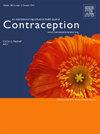EXPULSION RISK FACTORS FOR A LOW-DOSE COPPER IUD
IF 2.3
2区 医学
Q1 OBSTETRICS & GYNECOLOGY
引用次数: 0
Abstract
Objectives
This analysis evaluates expulsion rates among participants in a phase 3 study of a novel, low-dose copper (Cu 175mm2) intrauterine device (IUD) with a flexible nitinol frame.
Methods
In this prospective, single-arm, open-label study, participants at risk for pregnancy aged 17-45 received a Cu 175mm2 IUD and were followed for three years. This secondary analysis evaluates expulsion rates for all enrolled participants with successful device placement and used logistic regression to assess expulsion risk by parity, menstrual cup use (any time during study), BMI category, breastfeeding status, postpartum status (birth within one year prior to enrollment), and age.
Results
Of 1,601 participants who had the device successfully placed, 960 (60.0%) were nulliparous; 151 (9.4%) used menstrual cups; 510 (31.9%) had a BMI ≥30.0 kg/m2; 33 (2.1%) reported breastfeeding at the time of placement; and 127 (7.9%) were within one year postpartum. Participants’ mean (SD) age was 27.6 (5.8) years. Overall, 36 (2.2%) participants experienced device expulsion in year 1 and 63 (3.9%) over three years. Over three years, the Kaplan-Meier cumulative incidence of expulsion for menstrual cup users vs. non-menstrual-cup users was 0.11 (95% CI, 0.07-0.17) vs. 0.05 (95% CI, 0.03-0.06). Cumulative expulsion did not vary significantly based on parity, BMI category, breastfeeding status, or postpartum status. Logistic regression only associated menstrual cup use with IUD expulsion over three years (OR, 4.0; p<0.0001).
Conclusions
After three years of follow-up, novel Cu 175mm2 IUD users experienced a low rate of expulsion with only menstrual cup use associated with a significantly increased risk for IUD expulsion.
低剂量铜节育器排出危险因素
目的:本研究评估了一种新型低剂量铜(175mm2)柔性镍钛合金框架宫内节育器(IUD)的iii期研究参与者的排出率。方法在这项前瞻性、单臂、开放标签的研究中,17-45岁有怀孕风险的参与者接受了175mm2 Cu的宫内节育器,随访3年。这项二级分析评估了所有成功植入设备的参与者的驱逐率,并使用logistic回归评估了按胎次、月经杯使用(研究期间的任何时间)、BMI类别、母乳喂养状况、产后状况(入组前一年内出生)和年龄的驱逐风险。结果在1,601名成功放置该装置的参与者中,960名(60.0%)未生育;151例(9.4%)使用月经杯;BMI≥30.0 kg/m2 510例(31.9%);33名(2.1%)报告在放置婴儿时母乳喂养;产后1年内127例(7.9%)。参与者的平均(SD)年龄为27.6(5.8)岁。总体而言,36名(2.2%)参与者在第一年经历了器械驱逐,63名(3.9%)参与者在三年内经历了器械驱逐。在三年内,月经杯使用者和非月经杯使用者的Kaplan-Meier累积开除率分别为0.11 (95% CI, 0.07-0.17)和0.05 (95% CI, 0.03-0.06)。累积驱逐并未因胎次、BMI类别、母乳喂养状况或产后状况而有显著差异。Logistic回归仅将月经杯使用与三年内宫内节育器排出相关(OR, 4.0; p<0.0001)。经过三年的随访,新型cu175mm2宫内节育器使用者的排出率较低,仅使用月经杯与宫内节育器排出风险显著增加相关。
本文章由计算机程序翻译,如有差异,请以英文原文为准。
求助全文
约1分钟内获得全文
求助全文
来源期刊

Contraception
医学-妇产科学
CiteScore
4.70
自引率
17.20%
发文量
211
审稿时长
69 days
期刊介绍:
Contraception has an open access mirror journal Contraception: X, sharing the same aims and scope, editorial team, submission system and rigorous peer review.
The journal Contraception wishes to advance reproductive health through the rapid publication of the best and most interesting new scholarship regarding contraception and related fields such as abortion. The journal welcomes manuscripts from investigators working in the laboratory, clinical and social sciences, as well as public health and health professions education.
 求助内容:
求助内容: 应助结果提醒方式:
应助结果提醒方式:


